The New Art of Limiting
Featuring full loudness metering and DMGAudio's state of the art algorithms this is not your traditional dynamics processor.
Limitless implements multi-band dual-stage processing that intelligently separates dynamics and transients, and generates the smoothest possible gain reduction curves.
See what we mean: download the demo.
Features
- Cutting edge peak limiter to complete your mastering chain.
- Iterative solver algorithm provides the gentlest, most transparent limiting.
- Dual-stage dynamic handling separates transients and dynamics.
- Beautiful, minimalist user interface.
- Bit-transparent linear phase crossover.
- Inter-sample (True-) peak suppression.
- High-pass filter for DC removal.
- Simple and advanced modes: simple is click and bounce; advanced allows fine-grained control.
- 64x oversampled pre-limiter clipper with multiple clip algorithms.
- Noise-shaped dither with adjustable noise shaping intensity.
- Full integrated EBU R-128 Loudness metering.
- Extensive graphing and feedback.
- Windows VST, VST3 and AAX as 32+64bit, RTAS 32bit
- Mac VST, VST3, AU and AAX as 32+64bit, RTAS 32bit
Sound
- 6 band variable-slope Linear Phase crossover.
- State of the art iterative numerical solver for optimally smooth gain reduction.
- Dual-stage limiting to separate dynamics and transients.
- Style menu provides quick access to useful limiting characters.
- Variable stereo linkage.
- Full gain staging on input, clipper, limiter threshold and output ceiling.
- Master and per-band release controls.
- Loudness weighting control - to optimise for bass or perceptual loudness without EQ.
Vision
- Simple four-control interface.
- Advanced section for precision control.
- Spectrum analyser for crossover configuration.
- Time-plot to highlight peaks and visualise the clipping process.
- Loudness History with EBU R128 compliance.
- Freely-resizable UI.
- Mac Retina support.
- 8 A/B banks.
- Gain-lock to protect gain staging whilst auditioning presets.
- Configurable zoomable PPM and GR meters.
Windows System Requirements
- Vista / Windows 7 / Windows 8 / Windows 10
- 32bit or 64bit
- ProTools 7 or newer (RTAS and AAX Native)
- A host that supports VST or VST3, such as:
- Steinberg Cubase
- Steinberg Nuendo
- Steinberg Wavelab
- Sony ACID Pro
- Ableton Live
- Cockos Reaper
- Magix Sequoia
- Magix Samplitude
- AudioMulch
Mac OS System Requirements
- Mac OS 10.7 or newer. For 10.7 and 10.8 use the Intel 32/64 Mac Combined Installer on the Downloads page.
- Intel or Apple Silicon Mac
- ProTools 7 or newer (RTAS and 64-bit AAX Native, 32-bit AAX is not supported on Mac OS). For RTAS use the Intel 32/64 Mac Combined Installer on the Downloads page.
- A host that supports VST, AU or VST3, such as:
- Apple Logic (32bit or 64bit)
- Apple Garageband
- Steinberg Cubase
- Steinberg Nuendo
- Ableton Live
1.19 (2023-10-30)
- Add option to turn off frequency analyser.
- Fix incorrect latency on re-opening a project in Studio One.
- Fix latency reporting in VST3.
1.18 (2023-04-03)
- AAX Apple Silicon support.
- Fix crash when host dynamically changes plug-in input/output configuration.
1.17 (2022-11-23)
- Fix VST3 bundle structure for architecture on Windows.
1.16 (2022-11-03)
- Fix OpenGL crash in Pro Tools on macOS.
- Shift-Alt-click EQ graph background to reset analyser.
- Fix incorrect latency on re-opening a project in Ableton Live.
- Improve parameter display text reported to host for discrete parameters.
- Fix crash when moving between insert slots in Logic.
- Fix UI positioning in Reaper when window size is smaller than plug-in UI size.
- Fix duplicated preset data in VST3 preset file.
- VST3 can replace VST2 in Cubase/Nuendo 12 if missing or no longer supported.
1.15 (2022-03-28)
- Fix params not exposed to Pro Tools if inserted as a mono instance.
- Fix crash when loading a vst3 preset from host.
- Remove 32 bit AAX support on Mac.
- Improve parameter automation response at start of item if inserted as a Take FX in Reaper.
1.14 (2021-06-22)
- Fix VU meter scale when zoomed.
- Fix delay on glued audio clips in Reaper if Limitless inserted as Take FX and no audio processed before glueing.
- Fix band frequency changes propagating when switching AB banks with VST3 and AAX versions.
- Fix potential incorrect parameter recall with VST3 in Bitwig.
- Fix uninstaller location on Windows.
- Fix DPI scaling on Windows in apps that are not per-monitor aware.
1.13
- Fix clipper wet/dry delay when using HQ oversampling.
1.12
- Add HQ oversample option for clipper to Advanced DSP Setup page.
- Clipper dry path bypasses oversampling.
- Fix potential crash in Wavelab on scanning or instancing.
- Fix potential incorrect HPF frequency on loading project when sample rate is not 44.1kHz.
- Fix plugin not processing automation during silence when VST3 "suspend in silence" option is enabled in Cubase/Nuendo.
- Fix UI sizing on Windows when application is set to override DPI scaling.
- Fix click on switching bypass state.
- Fix locked param values not recalling correctly on loading plugin if preset was changed after locking.
- Fix locked params showing incorrect values after switching AB banks.
- Fix updating of track controls assigned to MIDI CCs in Reaper with VST3 version.
- Fix potential crash when instancing VST3 version in Harrison Mixbus.
- Update to new style load/save dialogs on Windows and fix initial path.
- Wrap mouse when editing controls if mouse hiding enabled.
- Fix UI zoom resetting on loading preset.
- Fix incorrect VST2 plugin window size with DPI scaling on Windows if host uses effEditGetRect flag (e.g. Tracktion Waveform and Max/MSP).
- Remove option to disable OpenGL on OSX and default to always enabled.
- Fix rendering of faders and VU meter if scaled to something other than 100% or 200% on Windows.
- Peak readouts are now sample accurate.
- Fix mouse hiding not working on Windows after entering a parameter as text.
- Fix band frequency not updating until mouse up when editing from band strip or tooltip.
1.11
- Fix potential crash when using different plugin formats in the same project.
1.10
- Fix potential crash when double-clicking to enter value as text.
- History graph scale and target now stored and recalled.
- Fix parameter MIDI learned state not being indicated after closing and reopening window.
- Fix flickering in time plot when sync mode is off.
- Improved undo of mouse wheel action.
- Fix time and history plots not scaling on high DPI displays on Windows.
- Fix MIDI learn in VST3 version.
- Fix crash when undoing preset load after closing and reopening UI.
1.09
- Improved HiDPI support
- Support VST2 getEffectName for some rare hosts
1.08
- Fix AU validation in old not-really-supported versions of Logic
- Reaper key entry improvements
- HiDPI support in Cubase and Studio One on Windows
- Improvements with discrete parameters drag/mousewheel
- Fix resetting loudness meters bug in Limitless
- Fix disappearing meters
1.07
- Fix for loudness not resetting until playback starts in some DAWs
- Time plot correctly aligns to bar position when sync mode on
- Grouped undo when editing parameters for multiple selected bands or for sanitised crossover frequencies
- Shift-Ctrl/Cmd-click on Threshold text label to show/hide an extra decimal place
- Fix crash after long period of use
- MIDI learn via right-click on parameter
- Fix crash when setup window open in more than one instance
- Undo/redo incorporates loading of presets and banks
- Correctly reinstate prev/next buttons status on opening window or loading a session
- Mac build now requires 10.7 or later
- Improve menu position when opening a menu would cause it to appear offscreen
- AAX Mac window focus improved
- Fix potential crash when file saving fails
- Accept ',' for decimal point when entering value by text
- Fix potential crash when closing UI
- Fix crash when closing UI with text box open
- Fix crash with text entry on touchbar MacBook Pro
- Prevent Cubase/Nuendo right-click menu from appearing when right-clicking on a clutter bar button that accepts right-clicks
- Support for mono->stereo AU
- Installer searches for existing VST plugins folder for 64-bit plugins on Windows if run for first time
- Correctly sign Windows installers with Codesigning cert
- Improve text and layout for Windows installers
- Improve install descriptions and logo for Mac installers
1.06
- New invisible ITU ISP algo.
- Options to save banks/presets to store A/B banks.
- Fix for recall of A/B settings
- OpenGL improvements
- Reduce graphics overheads
- Improve text editing on 64bit mac
- Improve VST3 automation
- Improve mousewheel handling on windows
- Improve keyboard handling
- Support VST3 GR metering in Studio One
- Improve automation resolution in Logic X
- Fix to disable dither on bypass
- Fix Input gain automation in ProTools
- Fix bug where resetting loudness statistics could show an over-read.
1.05
- Fix 32bit Carbon UIs on OSX.
- Fix pop when adjusting clipper drive.
- Prevent pops on enabling/disabling clipper.
- Add two new clipping shapes.
- Ceiling/Threshold text-entry - assume minus sign prefix.
- Clip/Dither can be enabled/disabled by clicking their headers.
- Threshold Pre-Clipper setting.
- Allow independent Separation control for Transient limiter.
- Added defence against non-numeric audio on input.
- Parameter in Advanced DSP to use ITU filter for ISP processing that never exceeds TP ceiling.
- "Lock" button now has right-menu for locking different subsets of controls.
- Pref to show Clipper GR on main VU GR.
- "Copy to manual" icon next to character menu.
1.04
- Fix automation issues in ProTools.
- Fix occasional fade-in at start of render.
- Fix preset load arrows bug.
- Fix bug with long lookahead and ISP enabled.
1.03
- Update AU validation.
- Allow all AUs to use Cocoa UIs on 32bit mac.
- Improve speed of session recall for AUs.
- Fix mousewheel on 2nd screens.
- Fix rare pop condition.
- Loudness follows Transport pref.
- Update OpenGL implementation.
- Allow disabling of OpenGL via pref - requires session reload.
- Improve latency reporting.
- Improve UI resize handling.
1.02
- Fix time-graph alignment
- Fix AU validation for Logic X/El Capitan
- Fix redraw crash
- Added Azuolas presets
- Fixed bug whereby saving a preset disabled left/right preset arrows
- Pref for filled GR draw on time graph
- Exporting of Loudness Data. (right-click history graph)
- Lock-out gain link control when gains are locked
- Updated manual
- Fix handling of presets a/b load/save
- Pref to ensure Ceiling doesn't jump after gain-link is disengaged
- Fixes for Sync mode on time graph
1.01
- Massive OpenGL overhaul
- Add pref (default ON) to optimise CPU at expense of latency
- Disable OpenGL for RTAS
- Fix denormal in loudness metering issue
- Optimise hard knee clipping
- Fix "save as default" button
- Fix GUI reloading
- Preserve Loudness data after a render (preference)
- Fix AutoListen bug
How Limitless works and a guide to Limiting
The Threshold control on a limiter is really an input gain. Limiting at the threshold and then turning the gain up is the same as turning the gain up and then limiting at 0dBFS.
The simplest limiter adds gain and clips. It wouldn't be much of a limiter, but it would make things louder. A more sophisticated limiter will work out how much gain is reduced when clipping and release it gently. More sophisticated still is the technique of delaying the audio (lookahead), to allow a gentle attack time. There's a problem with having one release time though, which is that either you set the release time short, so that it recovers quickly after a peak, and suffer it sounding aggressive on loud sustained material, or you set it long and have dips in level after every transient. In general, a compromise here is a bad compromise.
One solution to this problem is to automatically adapt the release time to the duration of the transient. This improves matters, but it depends on how well the algorithm adapts to your specific material. A better solution, and one that many engineers adopt, is to use a pair of limiters - one to control the dynamics, and another to catch the peaks. This is the strategy that Limitless adopts, but in an integrated way - the dynamics limiter allows transients to pass, configurably, letting the second stage catch the peaks.
Limitless also goes further, with a linear phase crossover of up to 6 bands. By separating out the bands we can prevent the scenario where one loud frequency drags down everything else. Multiband limiters have a reputation for sounding aggressive, when in fact they can achieve much greater transparency (as Limitless will demonstrate). The bad rap appears to be a consequence of the release time issue described above.
To a mathematician, limiting is a delightfully well specified problem. The peaks reach but do not exceed 0dBFS. Given another constraint, it's possible to formulate the problem in such a way that a numerical solver can be built to achieve certain criteria. In Limitless, the operating principle is that the most transparent limiting is a fixed gain reduction - so we strive for maximal smoothness of the gain reduction signals. With the constraints of peak limiting and maximal smoothness, we designed a numerical solver, which per-sample solves to find the gentlest possible adjustments that will prevent clipping.
So here's Limitless. It can be louder than other limiters without audible distortion, but that's not the point. Using Limitless you can achieve pop loudness without losing your dynamics. More importantly, Limitless is designed around modern loudness standards, so it's easy to target a specific Loudness - full metering and history is built in.
Another trick a lot of top-flight engineers use is clipping the signal before the limiter, to reduce the work the limiter has to do to peaks. Limitless features a full-spec clipper with massive oversampling, so you can achieve the "clipped convertor" effect inside the box. And at the output is a simple but thoroughly modern dither.
We're excited to introduce Limitless to the DMGAudio range, because now you can build a pro-grade mastering facility just from DMGAudio processors and a DAW, and you'll have the best gear money can buy whatever your objective.
On the other hand, if you just need to squeeze 6dB out of a render to test it on a big system tonight, Limitless makes it a 1-click affair, and it'll sound better than any alternative.
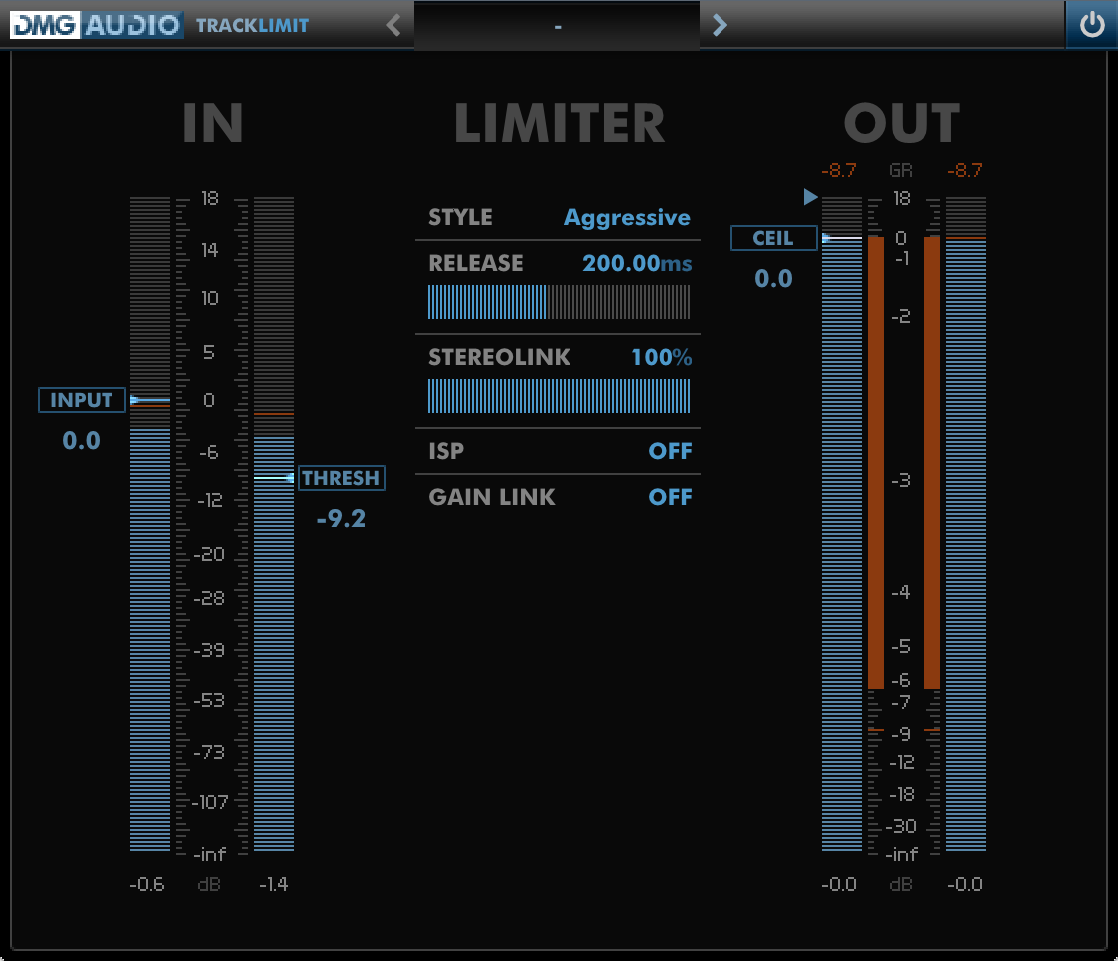 TrackLimit
TrackLimit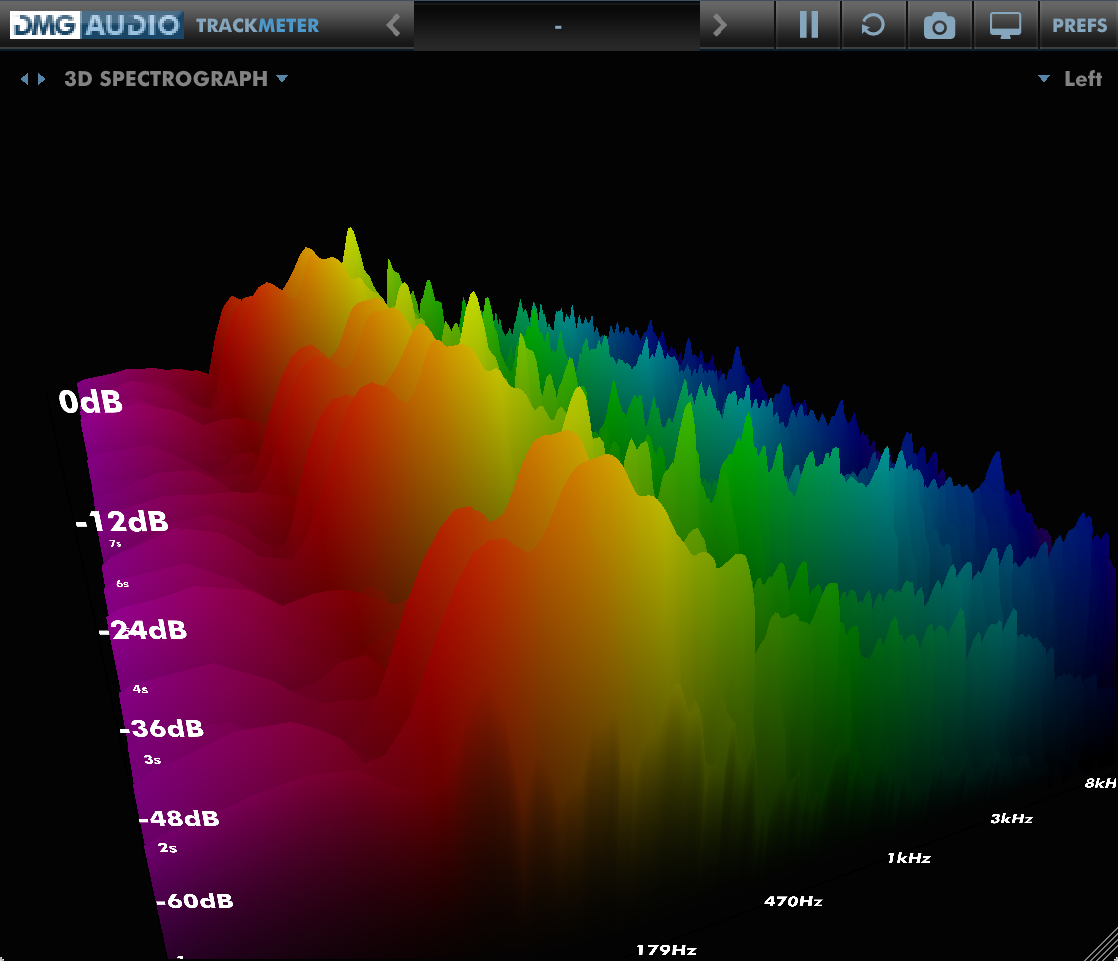 TrackMeter
TrackMeter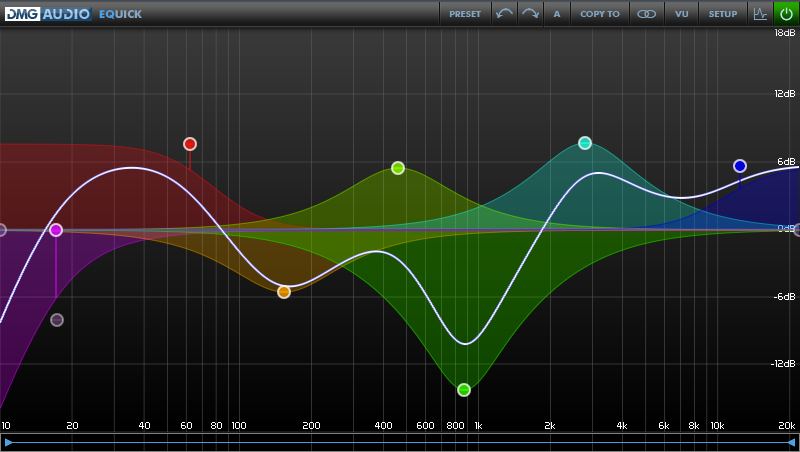 EQuick
EQuick
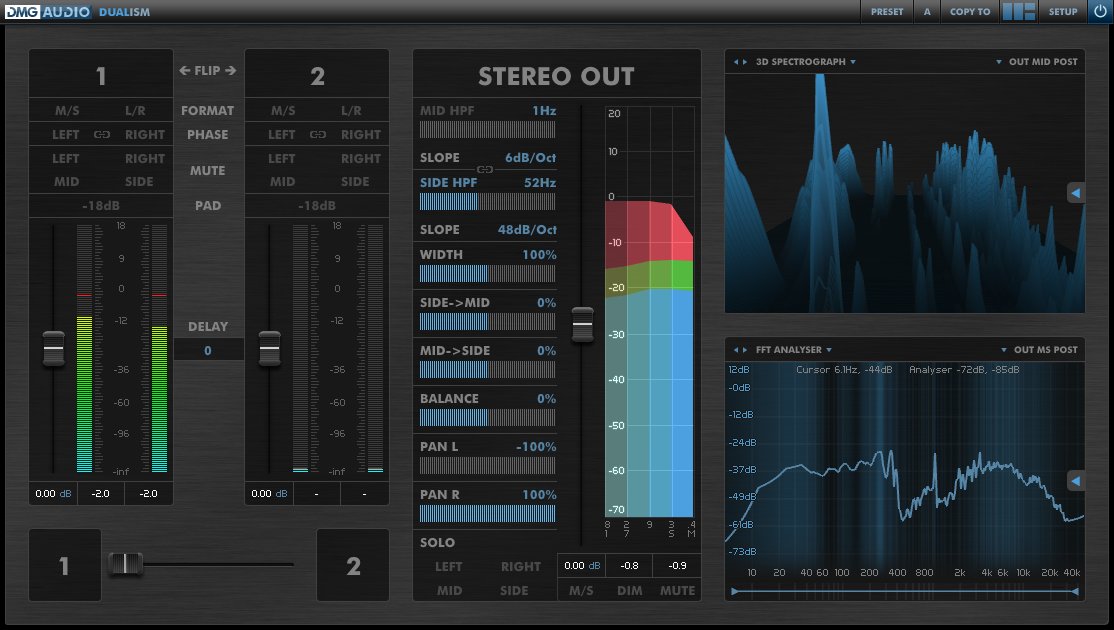 Dualism
Dualism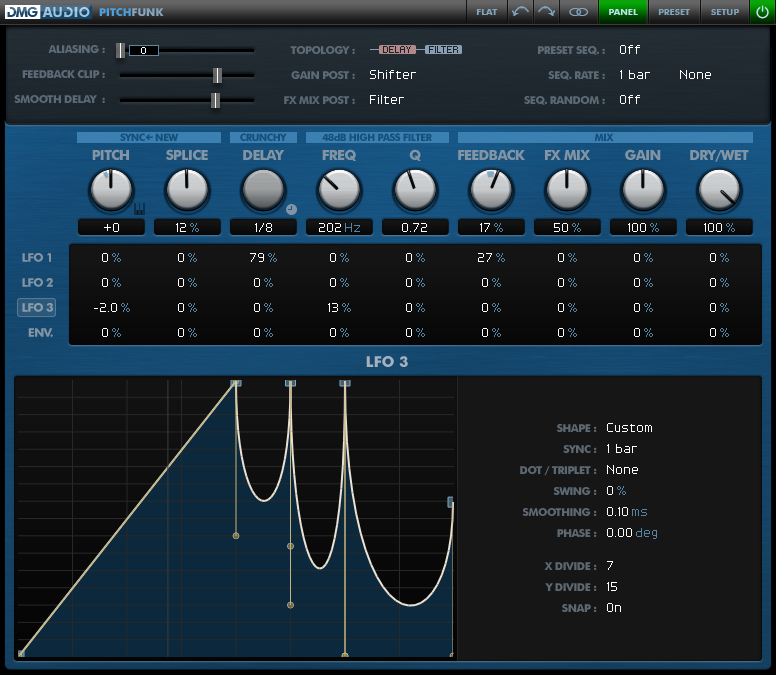 PitchFunk
PitchFunk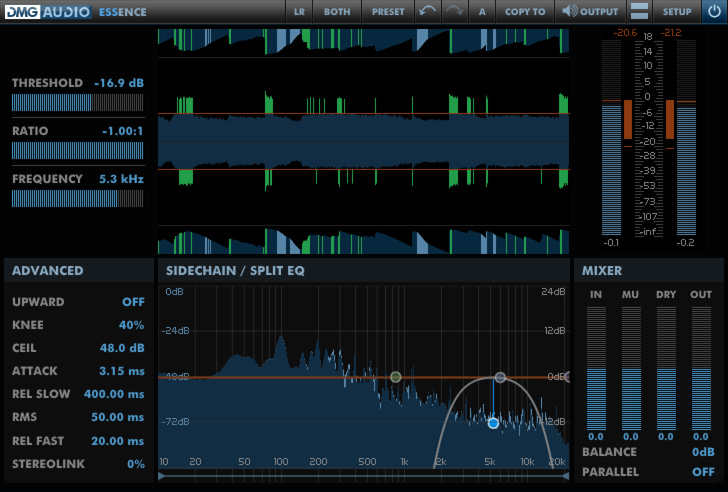 Essence
Essence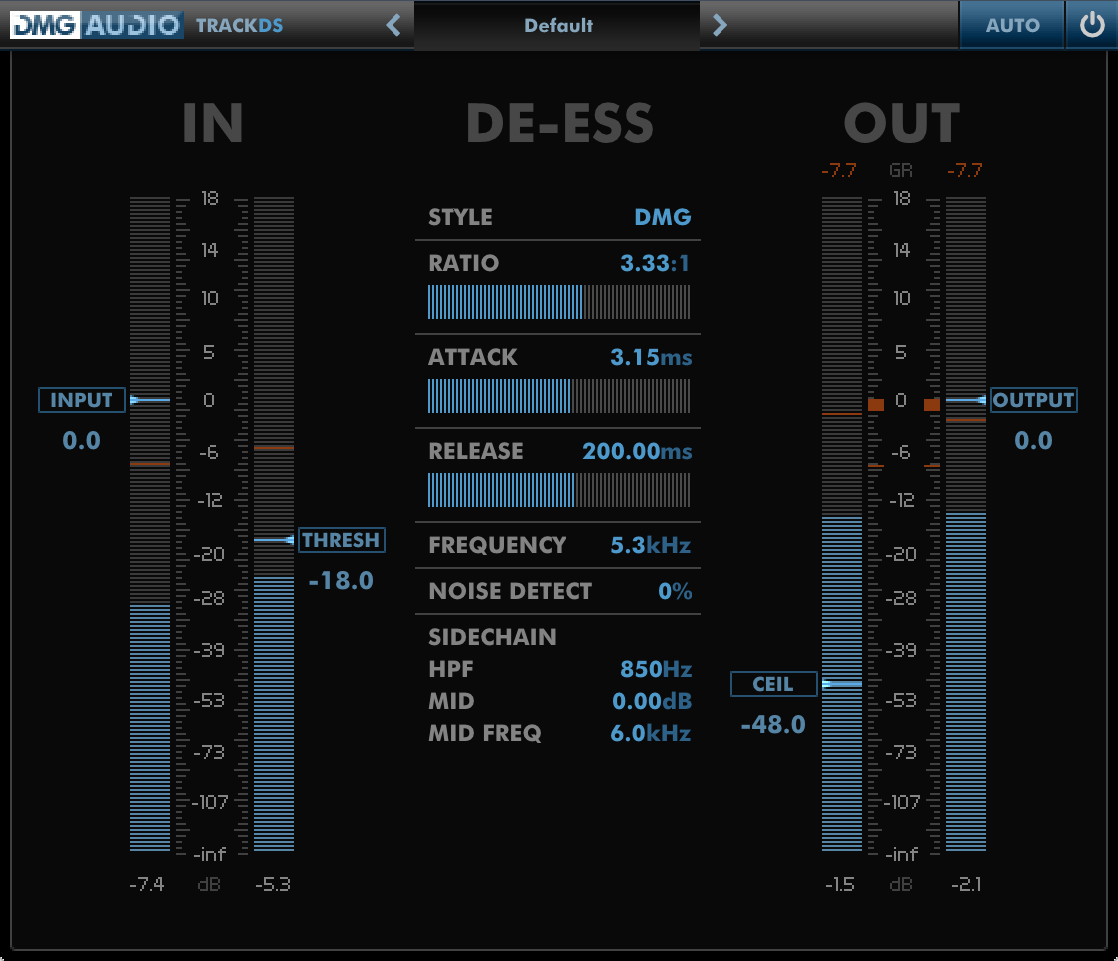 TrackDS
TrackDS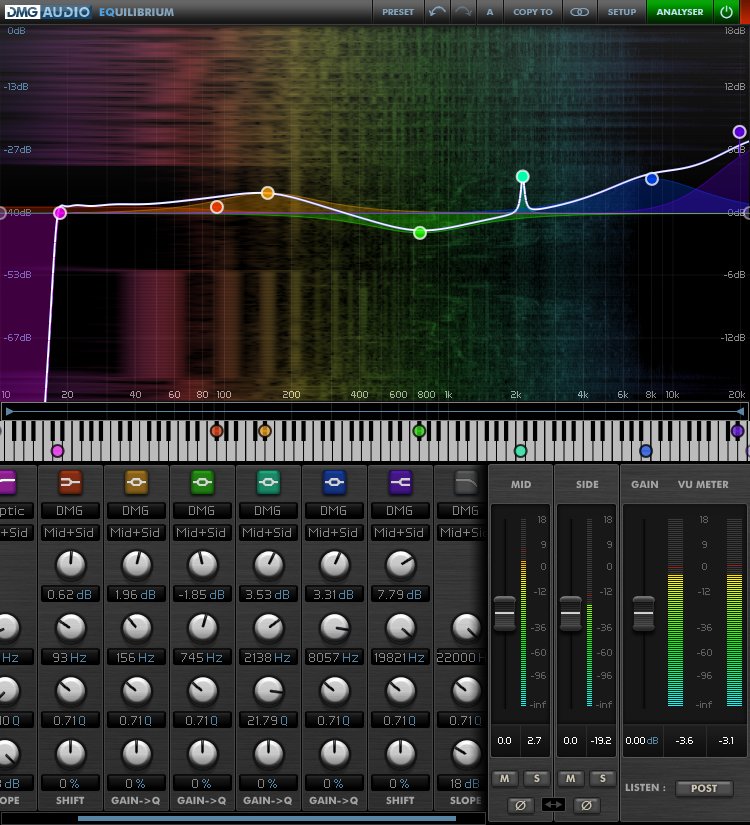 EQuilibrium
EQuilibrium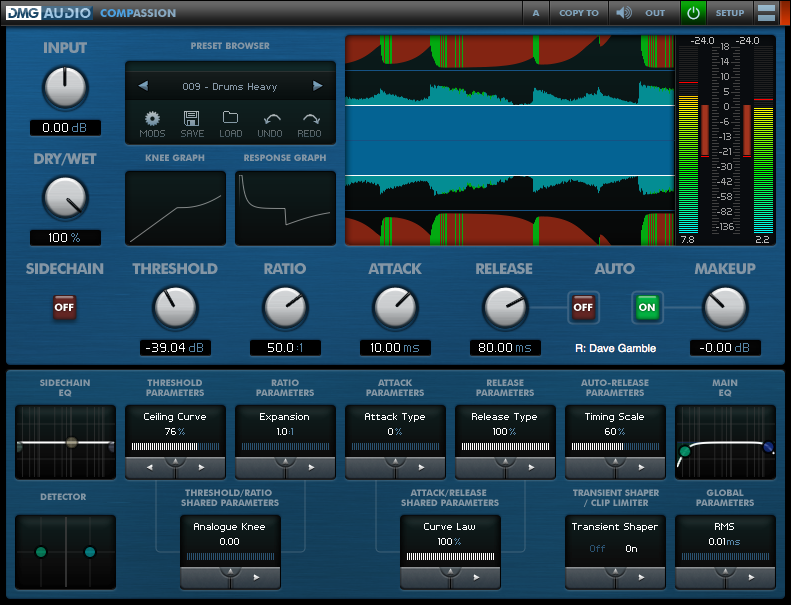 Compassion
Compassion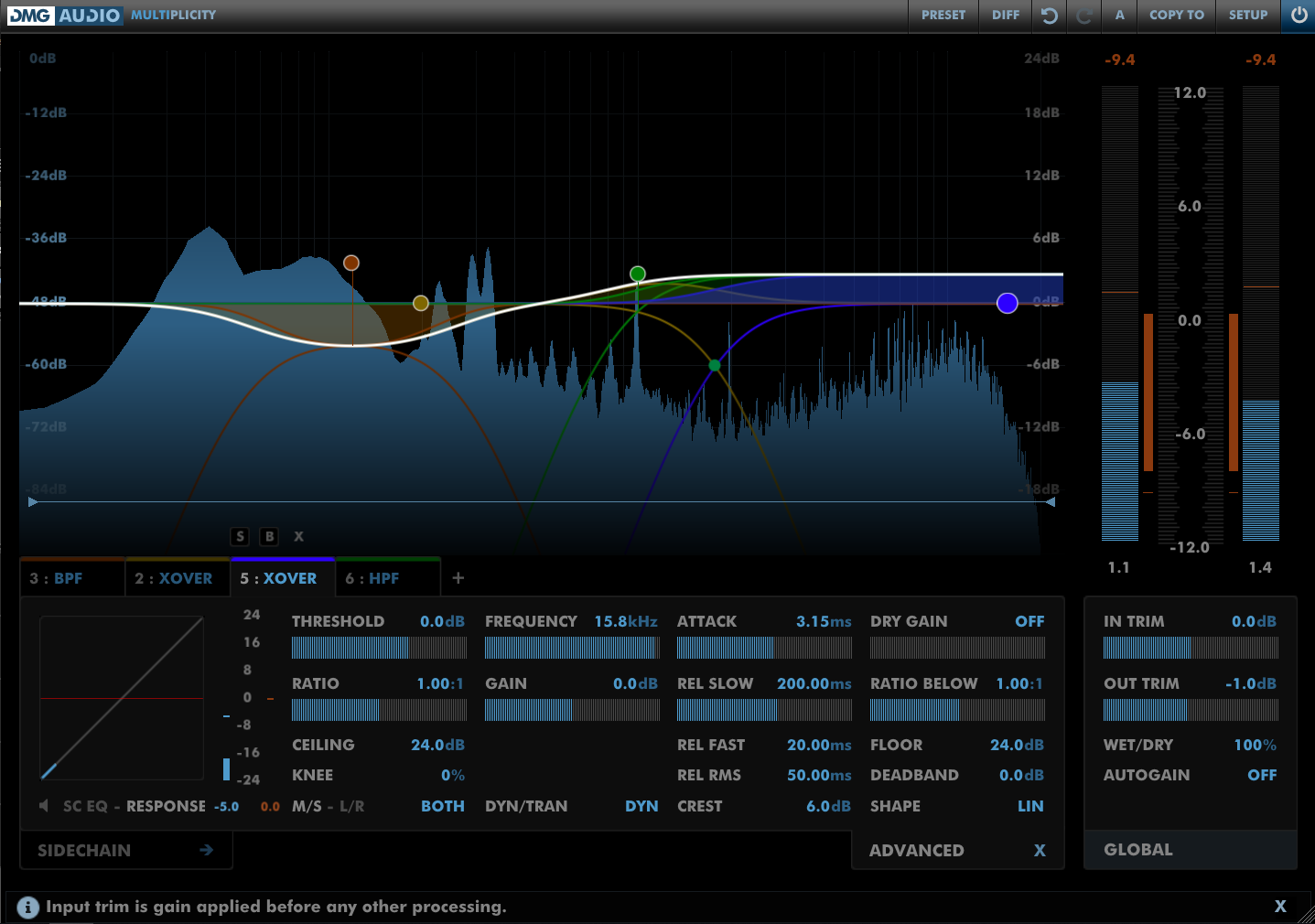 Multiplicity
Multiplicity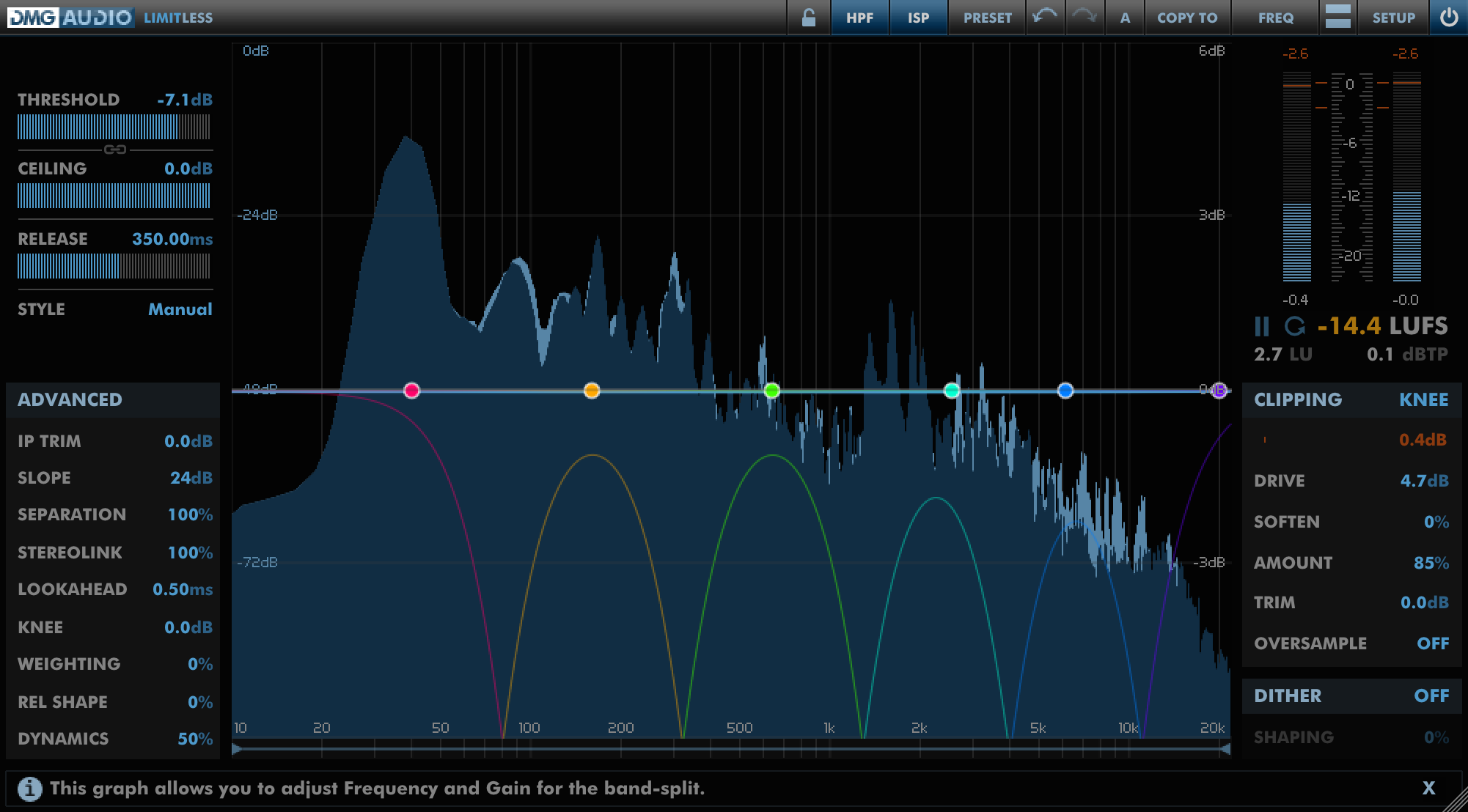 Limitless
Limitless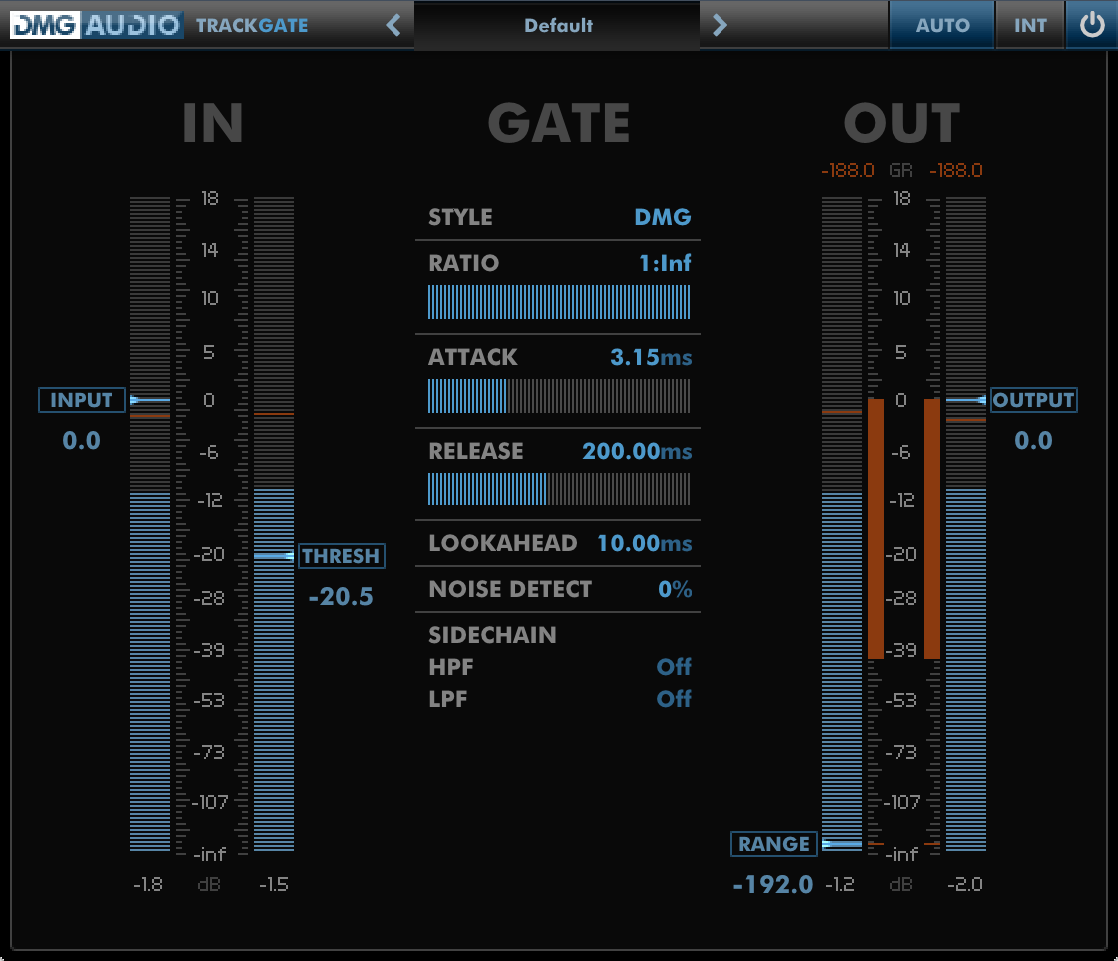 TrackGate
TrackGate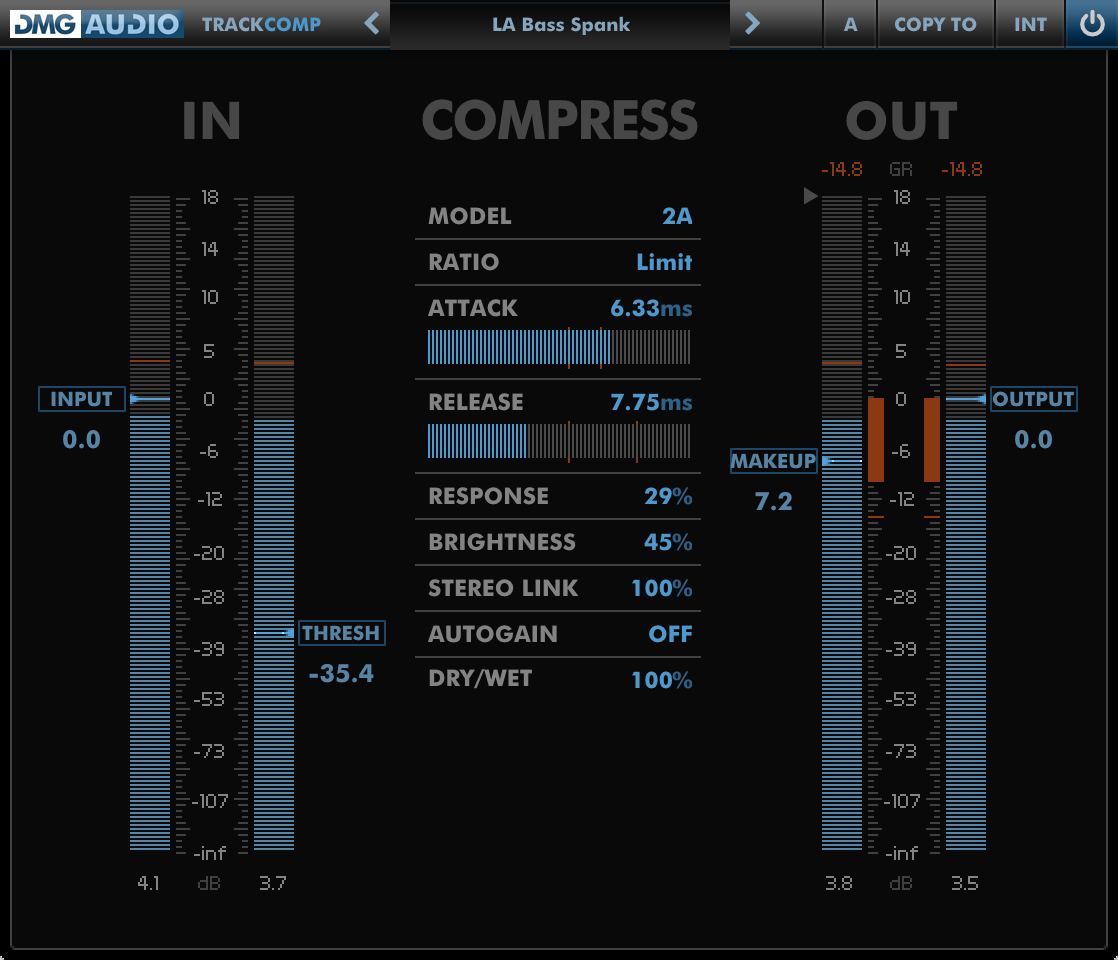 TrackComp 2
TrackComp 2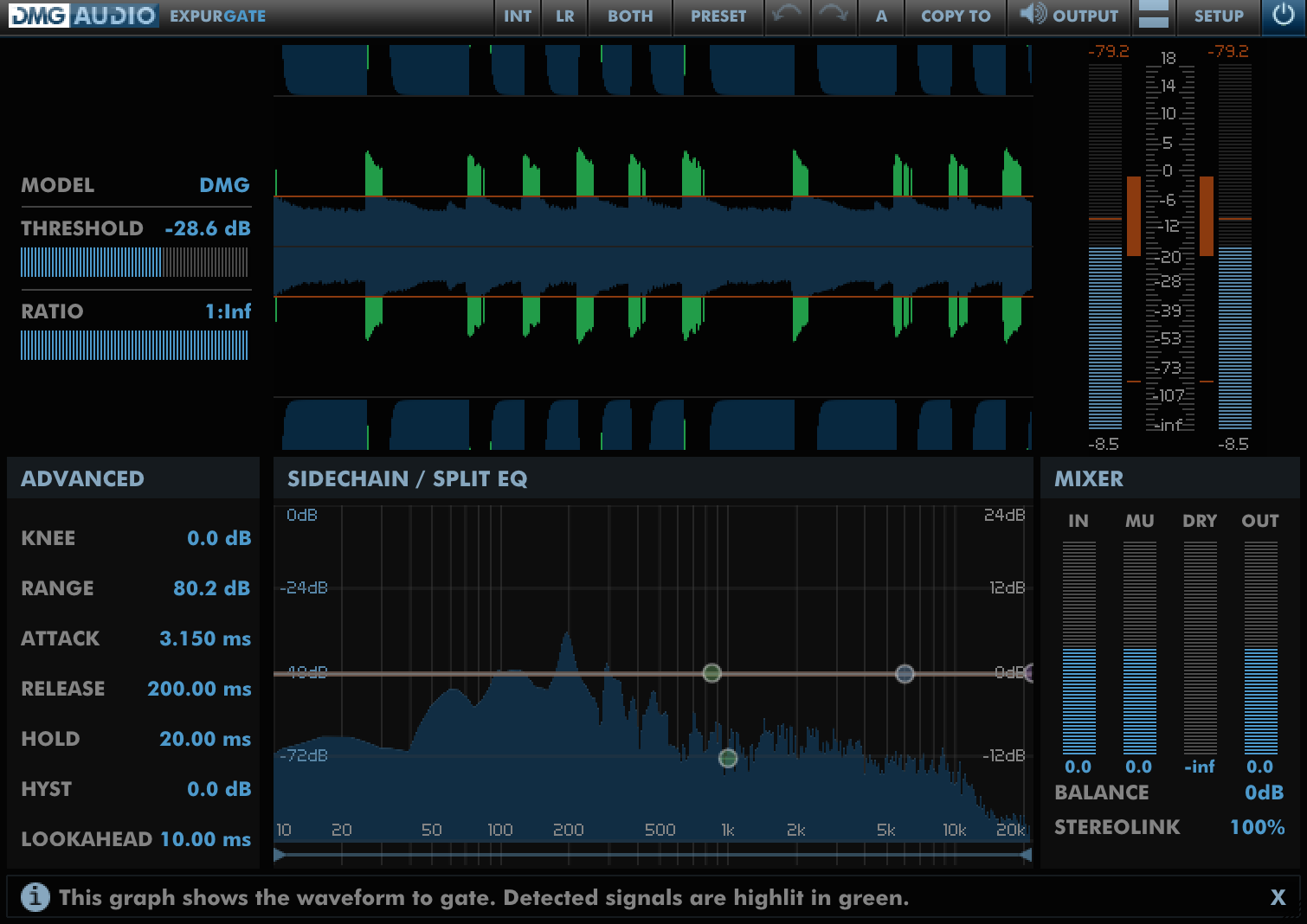 Expurgate
Expurgate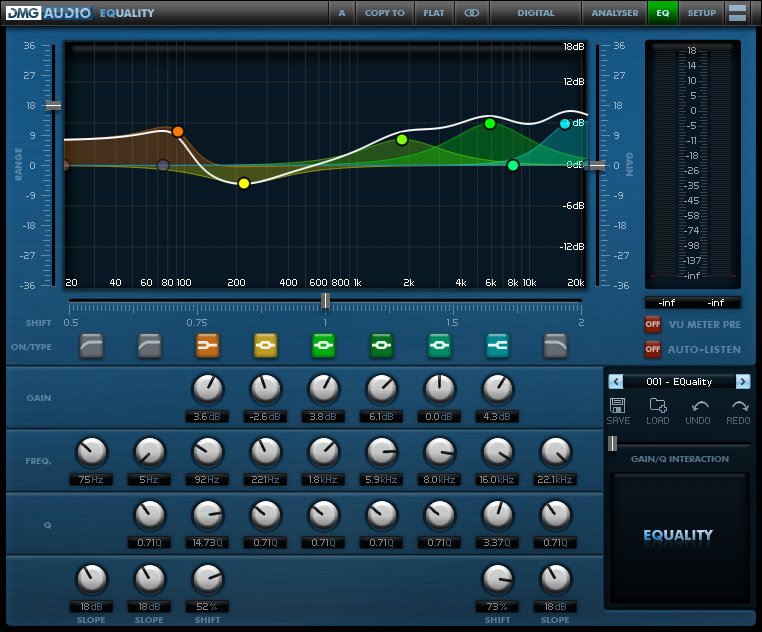 EQuality
EQuality



